Related Research Articles
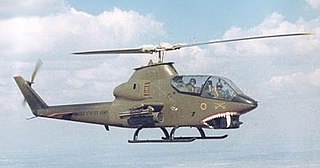
The Bell AH-1 Cobra is a single-engined attack helicopter developed and manufactured by the American rotorcraft manufacturer Bell Helicopter. A member of the prolific Huey family, the AH-1 is also referred to as the HueyCobra or Snake.
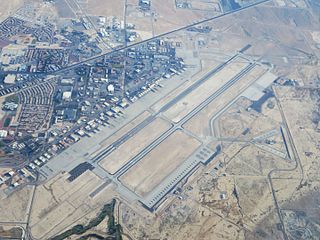
Nellis Air Force Base is a United States Air Force installation in southern Nevada. Nellis hosts air combat exercises such as Exercise Red Flag and close air support exercises such as Green Flag-West flown in "Military Operations Area (MOA) airspace", associated with the nearby Nevada Test and Training Range (NTTR). The base also has the Combined Air and Space Operations Center-Nellis.

The Mil Mi-24 is a large helicopter gunship, attack helicopter and low-capacity troop transport with room for eight passengers. It is produced by Mil Moscow Helicopter Plant and was introduced by the Soviet Air Force in 1972. The helicopter is currently in use by 58 countries.
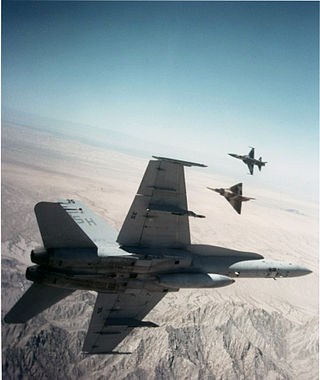
Air combat manoeuvring (ACM) is the tactic of moving, turning, and situating one's fighter aircraft in order to attain a position from which an attack can be made on another aircraft. Commonly associated with dogfighting, air combat manoeuvres rely on offensive and defensive basic fighter manoeuvring (BFM) to gain an advantage over an aerial opponent.
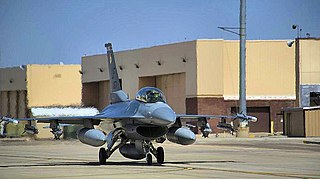
Holloman Air Force Base is a United States Air Force base established in 1942 located six miles (10 km) southwest of the central business district of Alamogordo, which is the county seat of Otero County, New Mexico, United States. The base was named in honor of Col. George V. Holloman, a pioneer in guided missile research. It is the home of the 49th Wing of the Air Education and Training Command (AETC).

Tactical Air Command (TAC) is an inactive United States Air Force organization. It was a Major Command of the United States Air Force, established on 21 March 1946 and headquartered at Langley Air Force Base, Virginia. It was inactivated on 1 June 1992 and its personnel and equipment absorbed by Air Combat Command (ACC).

Shaw Air Force Base (Shaw AFB) (IATA: SSC, ICAO: KSSC, FAA LID: SSC) is a United States Air Force (USAF) base located approximately 8.4 miles (13.5 km) west-northwest of downtown Sumter, South Carolina. It is one of the largest military bases operated by the United States, and is under the jurisdiction of USAF Air Combat Command (ACC). The 20th Fighter Wing (20th FW) is the host unit.

The Air Education and Training Command (AETC) is one of the nine Major Commands (MAJCOM) of the United States Air Force (USAF), reporting to Headquarters, United States Air Force. It was established 1 July 1993, with the realignment of Air Training Command and Air University.

In aerobatics, the cobra maneuver, also called dynamic deceleration, among other names, is a dramatic and demanding maneuver in which an airplane flying at a moderate speed abruptly raises its nose momentarily to a vertical and slightly past vertical attitude, causing an extremely high angle of attack and momentarily stalling the plane, making a full-body air brake before dropping back to normal position, during which the aircraft does not change effective altitude.
Combat flight simulators are vehicle simulation games, amateur flight simulation computer programs used to simulate military aircraft and their operations. These are distinct from dedicated flight simulators used for professional pilot and military flight training which consist of realistic physical recreations of the actual aircraft cockpit, often with a full-motion platform.

Exercise Red Flag is a two-week advanced aerial combat training exercise held several times a year by the United States Air Force. It aims to offer realistic air-combat training for military pilots and other flight crew members from the United States and allied countries.

A Weapon Systems Officer (WSO), nicknamed "Wizzo", is an air flight officer directly involved in all air operations and weapon systems of a military aircraft.

Dissimilar air combat training (DACT) was introduced as a formal part of US air combat training after disappointing aerial combat exchange rates in the Vietnam War.

403 "City of Calgary" (Helicopter) Operational Training Squadron is a squadron of the Royal Canadian Air Force (RCAF) located at Canadian Forces Base Gagetown. It is equipped with CH-146 Griffons and provides operational aircrew training to the crews who will fly the helicopter. The squadron also conducts operational test and evaluation, develops aviation tactics and carries out operations in support of the 1 Wing mission. It also supports the local Army requirements of the Combat Training Centre. It was founded as No. 403 Squadron RCAF.
Supermaneuverability is the capability of fighter aircraft to execute tactical maneuvers that are not possible with purely aerodynamic techniques. Such maneuvers can involve controlled side-slipping or angles of attack beyond maximum lift.

The 138th Attack Squadron is a unit of the New York Air National Guard's 174th Attack Wing located at Hancock Field Air National Guard Base in Syracuse, New York. The 138th is equipped with the MQ-9 Reaper Remotely Piloted Aircraft (RPA).
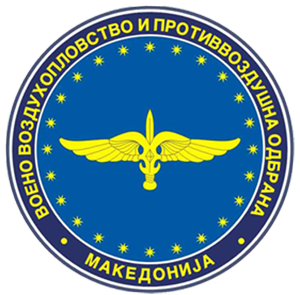
The North Macedonia Air Brigade is the air warfare and air defense force of the Army of the Republic of North Macedonia.

The 20th Operations Group is the flying component of the 20th Fighter Wing, assigned to the United States Air Force Air Combat Command. It is stationed at Shaw Air Force Base, South Carolina. It is a successor organization of the 20th Pursuit Group, one of the 15 original combat air groups formed by the U.S. Army before World War II.

The 49th Operations Group is the operational flying component of the United States Air Force 49th Wing. It is stationed at Holloman Air Force Base, New Mexico, and is a part of Air Combat Command (ACC).

The Joint Attack Helicopter Instrumented Evaluation was a series of military exercises that tested the use of attack helicopters against simulated Warsaw Pact formations. They were carried out near Ansbach, Germany, between March and May 1972, primarily by units of the US 7th Army and the German Army, with active participation from the Canadian Army. In historical works, they are often known as the Ansbach Tests.
References
This article needs additional citations for verification .(February 2018) |
Notes
- ↑ Tindoll Jr, Davis (3 December 1996). Dedicated Army aviation unit for counter air operations is it necessary? (PDF) (Technical report). U.S. Army Command and General Staff College. p. 20. Archived (PDF) from the original on February 22, 2017.
- 1 2 3 Vallimont, p. 25.
- ↑ NASA Langley: The Flight Simulation Facilities (PDF), USA: NASA, 14 May 2019.
- 1 2 Vallimont, p. 26.
- 1 2 3 "20th SOC; Missions 1979–1990", Hornet's new, USAF.
- ↑ Verti-Flight, American Helicopter Society, 1988, p. 40.
- ↑ The Red Scarf, The Pave Cave, archived from the original on 2011-07-17, retrieved 2011-04-13.
Bibliography
- Vallimont, Joe (9 March 1979), "J-CATCH", sof hi-lites (PDF), vol. 19, The Pave Cave, pp. 24–8, archived from the original (PDF) on 7 October 2011, retrieved 13 April 2011.